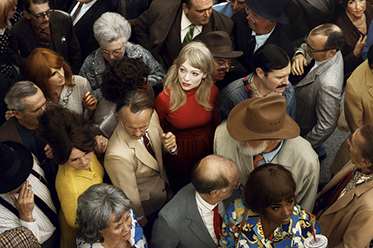 LA photographer Alex Prager is currently exhibiting short films and film stills at the National Gallery of Victoria (NGV) in Melbourne.
LA photographer Alex Prager is currently exhibiting short films and film stills at the National Gallery of Victoria (NGV) in Melbourne.
There is something authentic behind the artifice of her highly staged images of, among other things, crowds. You can imagine Prager telling the actors, “just act naturally,” and they do. I’m struck by how successful the performance is despite the highly scripted media-saturated nature of contemporary living.
Beneath the surface of Prager’s self-consciously extravagant melodramatic form lies something more reflective. What’s significant I think is that, for better or worse, Hollywood-style sentiment helps shape our most serious lived experiences.
As I prepare to teach American Literature again in Melbourne, Prager’s work suggests how I might temper a tendency among my students to be suspicious of anything coming from the US. At the end of the so-called American century, the values routinely endorsed by the US administration often bring all of American culture into disrepute.
At the same time, American economic and industrial power on the world stage has been waning since its heyday following the second world war. In what some call “post-American” times, the US economy is losing its edge in the global market, particularly in competition with China.
If experience is anything to go by, my students in American Lit this semester will be well informed about the War on Terror, the notorious Abu Ghraib torture revelations, the fiasco of US involvement in Iraq, racial riots, classroom shootings and other domestic tensions.
So I need to remind them that many of the authors we are reading were as critical of US policies as they are. Prager’s melodramatic photographs and films inspire a reappraisal of the hopes originally inscribed in the American Dream.
I’m not denying the traumas associated with US foreign and domestic policy. My point is that, behind the facade of her stripped-down melodrama, Prager takes seriously sentiments, such as optimism and belief, that are central to contemporary human experience.
Though Prager is all LA, all Hollywood, many Australians (and others) attending the exhibition will recognise something of their own sensibility in her images. That’s because Prager taps into a currency of American myth-making that’s now part of a Western cultural repertoire, including aspects of the American Dream.
Any subject on American Literature must include the concept of the American Dream. It’s written in the constitution as the right to pursue happiness. It means that no matter how desperate the conditions of one’s birth, if one works hard enough, one can rise to become the president of the United States of America.
But if Puritan values founded the American Dream of spiritual fulfilment, it soon outgrew those strictures. To Ralph Waldo Emerson, the American Dream was premised on individual freedom and self-reliance. To Walt Whitman, it meant singing the nation into being as a choir of individual voices, giving expression to “the word Democratic, the word, En-Masse” as he declares in Leaves of Grass.
In tutorials, students often reject the idea that the American Dream ever had any currency. However, when I boot up a YouTube of Sylvia Plath reading her poem Daddy their ears prick up. Students appreciate the strength in Plath’s voice. It shows them another side of this often pathologised poet. Here, she breaks out of the 1950s Stepford Wife stereotype and uses Holocaust imagery to denounce the daddy in her poem, who is ultimately synonymous with patriarchy and military aggression.
In reproaching her “Daddy,” Plath rejects the smug American complacency of the 1950s that would have smothered her aspirations had she not won a Fulbright Scholarship and taken flight to England.
In Kurt Vonnegut, students find another author whose anti-war stance favours, in fact, a romantic take on Puritan aspirations (at least for Billy Pilgrim, hero of Slaughterhouse Five). Vonnegut’s anti-war writings impress students who are inspired by the recent Occupy Movement.
And that’s exactly it. Strangely, I suspect there is an element of the American Dream circulating in a lot of anti-American feeling. In a “post-American” world, American ideals have flown the coop. One thing is for sure, the American Dream always disputes the law of gravity: one can always rise beyond one’s origins, move with the times and escape conventional limits. One might even fly.
This happens in Prager in her short film Despair (2010). A troubled woman throws herself out of a fifth-floor window. While the sun descends she seems to float and her despair dissipates. What eventually falls to earth are only her red shoes and some broken glass. The woman herself is gone and in her place remain these trappings of feminine iconography.
Here, Prager isn’t just giving us a story of escape from oppression, told in melodramatic style. Instead, the heroine in this film becomes a self-reflexive representative of the style of melodrama itself. It’s as if, in these straitened neo-liberal times, an extravagant aesthetic form is being saved from capture within an overblown sentimentality, or grim cynicism.
Prager’s serious levity invites belief. To me it is a means of showing students how to critique the American Dream while still recognising that its vocabulary of hope is theirs as well, having travelled far to reach them. Work by Alex Prager is at the National Gallery of Victoria until April 19.
The American Dream is yours, and this is your wake-up call
By Sofia Ahlberg, La Trobe University
This article was originally published on The Conversation. Read the original article.
Image: American 1979–Crowd #2 (Emma) 2012, pigment print, 142.0×151.0cm. Collection of Dr Clinton Ng, Sydney © Alex Prager, courtesy of the artist and Lehmann Maupin, New York and Hong Kong
